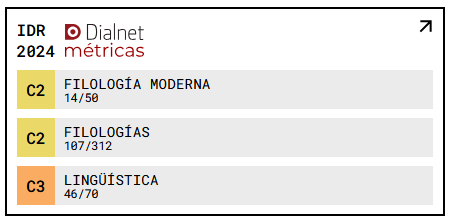Do anxiety and English proficiency level affect writing performance in second language (L2) learning?
DOI:
https://doi.org/10.18172/jes.3151Keywords:
Writing performance in L2, anxiety, English proficiency level, adolescenceAbstract
The present study shows a piece of research conducted to establish the degree of correlation between anxiety and English proficiency level of adolescents with writing performance in second language (L2) learning. For this purpose, we have developed a predictive-correlational study taking under consideration students from ahigh schoolofGranada(Spain). In our present study, we find that the English proficiency level predictor variable is more closely correlated with writing performance than anxiety. Although the anxiety variable has shown a negative correlation to writing performance, only the former English Proficiency Level has been included in the linear multiple regression model as the single and efficient predictor.
Downloads
References
Akse, J., Hale, W. W., Engels, R. C., Raaijmakers, Q. A. and W. H. Meeus.
“Stability and change in personality type membership and anxiety in adolescence”. Journal of Adolescence, 30 (5): 813-834.
Bayliss, D. and P. M. Raymond. 2004. “The Link Between Academic Success and L2 Proficiency in the Context of Two Professional Programs”. The Canadian Modern Language Review (La revue canadienne de langues vivantes) 61 (1): 29-51.
Bickman, L. and D. J. Rog, eds. 2009. The SAGE Handbook of Applied Social Research Methods. (2nd Ed.). Thousand Oaks, CA: Sage Publications. Inc. http:// doi.org/10.4135/9781483348858.
Bonifacci, P., Candria, L. and S. Contento. 2008. “Reading and Writing: What is the Relationship with Anxiety and Depression?” Reading and Writing: An Interdisciplinary Journal 21 (6): 609-625.
Cheng, Y., Horwitz, E. K. and D. L. Schallert. 1999. “Language Anxiety: Differentiating Writing and Speaking Components”. Language Learning 49 (3): 417-446.
Cheng, Y. 2002. “Factors Associated with Foreign Language Writing Anxiety”. Foreign Language Annals 35: 647-656. http://doi.org/10.1111/j.1944-9720.2002.tb01903.x.
Cheng, Y. 2004. “A Measure of Second Language Writing Anxiety: Scale Development and Preliminary Validation”. Journal of Second Language Writing, 13 (4): 313-335.
Dordinejad, F. G. and R. M. Ahmadabad. 2014. “Examination of the relationship between foreign language classroom anxiety and English achievement among male and female Iranian high school students”. International Journal of Language Learning and Applied Linguistics World 6 (4): 446-460.
Grant, D. M. 2013. “Anxiety in Adolescence”. Handbook of Adolescent Health Psychology. Eds. W. O’Donohue, L. Benuto and L. Woodward Tolle. New York: Springer Science + Business Media. 507-519.
Hogan, T. 2004. Pruebas psicológicas una introducción práctica. D.F. México: Manual Moderno.
Horwitz, E. K. 2001. “Language Anxiety and Achievement”. Annual Review of Applied Linguistics 21: 112-126.
Horwitz, E. K., Horwitz, M. B. and J. Cope. 1986. “Foreign Language Classroom Anxiety”. The Modern Language Journal 70 (2): 125-132.
Hubert, M. D. 2013. “The Development of Speaking and Writing Proficiencies in the Spanish Language Classroom: A Case Study”. Foreign Language Annals 46 (1): 88-95.
Kahane, L. 2008. Regression Basics (2nd ed.). Thousand Oaks, CA: Sage Publications.
Liu, M. 2006. “Anxiety in Chinese EFL Students at Different Proficiency Levels”. System: An International Journal of Educational Technology and Applied Linguistics 34 (3): 301-316.
Mascle, D. D. 2013. “Writing Self-Efficacy and Written Communication Skills”. Business Communication Quarterly 76 (2): 216-225.
Matsuda, S. and P. Gobel. 2004. “Anxiety and Predictors of Performance in the Foreign Language Classroom”. System. An International Journal of Educational Technology and Applied Linguistics 32 (1): 21-36.
MacIntyre, P. D. and R. C. Gardner. 1989. “Anxiety and Second-Language Learning: Toward a Theoretical Clarification”. Language Learning 39 (2): 251-275.
Melanliog˘lu, D. 2013. “Impacts of Authentic Listening Tasks Upon Listening Anxiety and Listening Comprehension”. Academic Journals 8 (14): 1177-1185.
Meltzoff, J. 2000. Critical Thinking About Research: Psychology and Related Fields. Washington, D.C: APA.
Meyers, L., Gamst, G. and A. J. Guarino. 2013. Applied Multivariate Research Design and Interpretation (2nd ed.). Thousand Oaks, CA: Sage Publications.
Moretti, R. Torre, P., Antonello, R., Fabbro, F. Cazzo, G. and A. Bora. 2003. Writing errors by normal subjects. Perceptual and Motor Skills 97: 215-229.
Muñiz, J. 2003. Teoría Clásica de los Tests. Madrid: Pirámide.
Pae, T. L. 2013. “Skill-Based L2 Anxieties Revisited: Their Intra-Relations and the Inter-Relations with General Foreign Language Anxiety”. Applied Linguistics 34 (2): 232-252.
Payne, G. and M. Williams. 2011. Teaching Quantitative Methods: Getting the Basics. London: Sage Publications, Ltd. http://doi.org/10.4135/9781446268384.
Remler, D. and G. G. Van Ryzin. 2014. Research Methods in Practice.Strategies for Description and Causation. (2nd ed.). Thousand Oaks, CA: Sage Publications.
Sparks, R. L., Patton, J., Ganschow, L. and N. Humbach. 2009. “Long-Term Relationships Among Early First Language Skills, Second Language Aptitude, Second Language Affect, and Later Second Language Proficiency”. Applied Psycholinguistics 30 (4): 725-755.
Stephenson, J. T. 2006. Anxiety in Learning English Foreign Language: Its Associations with Student Variables, With Overall Proficiency and with Performance on an Oral Test. Doctoral Thesis. Universidad de Granada: Universidad de Granada.
Teksan, K. 2012. “Analysis of Writing Anxiety of Secondary School Students According to Several Variables”. Educational Research and Reviews 7 (22): 487-493.
Trochim, W. and J. Donnelly. 2006. The Research Methods Knowledge Base. Mason. Ohio: Atomic Dog.
Woodrow, L. 2011. “College English Writing Affect: Self-Efficacy and Anxiety”. System: An International Journal of Educational Technology and Applied Linguistics 39 (4): 510-522.
Zhang, X. 2013. “Foreign Language Listening Anxiety and Listening Performance: Conceptualizations and Causal Relationships”. System: An International Journal of Educational Technology and Applied Linguistics 41 (1): 164-177.
Downloads
Published
How to Cite
Issue
Section
License
The authors retain copyright of articles and authorize Journal of English Studies the first publication. They are free to share, redistribute, and/or reprint the article without obtaining permission from the publisher as long as they give appropriate credit to the editor and the journal.
Self-archiving is allowed too. In fact, it is recommendable to deposit a PDF version of the paper in academic and/or institutional repositories.
It is recommended to include the DOI number.
This journal is licensed under a Creative Commons Attribution 4.0 International License













